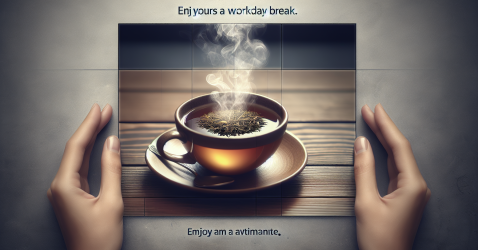Mindful Workday: Incorporating Awareness Into Your Job
In today’s fast-paced world, finding moments of mindfulness and self-awareness can seem like a luxury. However, incorporating mindfulness into your workday can have tremendous benefits for your overall well-being and productivity. By taking conscious breaks, practicing deep breathing techniques, and cultivating gratitude, you can create a more balanced and fulfilling work environment. In this article, we will explore simple yet effective ways to infuse mindfulness into your daily work routine, helping you find inner peace and focus amidst the chaos of the modern workplace.
Creating a Mindful Work Environment
In today’s fast-paced and demanding work environment, it’s essential to create a mindful and balanced atmosphere that promotes productivity and well-being. By setting intention for the day, organizing your workspace, and minimizing distractions, you can cultivate a work environment that supports focus, clarity, and overall mindfulness.
Setting Intention for the Day
One of the most impactful ways to start your workday mindfully is by setting an intention. Take a few moments each morning to identify the quality or attitude you want to bring to your work. By consciously choosing how you want to show up in your tasks and interactions, you set the tone for a more meaningful and focused day ahead.
Organizing Your Workspace
The state of your physical environment greatly affects your mental state. To create a mindful work environment, declutter and organize your workspace. Remove any unnecessary items and ensure essential tools are easily accessible. A neat and tidy workspace promotes a sense of calm and clarity, allowing you to focus more effectively and be fully present in your work.
Minimizing Distractions
In our modern work environment, distractions are abundant. To cultivate mindfulness, it’s crucial to identify and minimize distractions that hinder your concentration and productivity. Consider turning off email notifications, silencing your phone, and utilizing noise-canceling headphones if needed. Creating boundaries and intentionally designing your environment to support focus will allow you to be more present and engaged in your work.
Practicing Mindful Communication
Effective and mindful communication is essential for fostering positive relationships, collaboration, and a supportive work environment. By practicing active listening, nonviolent communication, and empathy and compassion, you can enhance your communication skills and cultivate a more mindful workplace.
Active Listening
Active listening involves not only hearing the words being spoken but also paying attention to non-verbal cues and fully engaging with the speaker. By giving your full presence and attention to the person speaking, you create a safe and supportive space for authentic communication. This practice promotes understanding, connection, and effective collaboration.
Nonviolent Communication
Nonviolent communication, developed by Marshall Rosenberg, focuses on compassionate and empathetic communication to resolve conflicts and build understanding. By using language that is nonjudgmental, expressing observations, feelings, needs, and making concrete requests, you can foster greater understanding and empathy in your workplace interactions.
Empathy and Compassion
Empathy and compassion are essential ingredients in cultivating mindful relationships at work. By putting yourself in others’ shoes and genuinely seeking to understand their experiences, you foster a sense of connection and support. Show empathy by actively listening, validating others’ emotions, and offering your support when needed. Cultivating compassion allows you to respond to others’ challenges with kindness and understanding, creating a more harmonious and mindful work environment.
Mindful Time Management
Time management is crucial for maintaining focus, productivity, and overall well-being. By prioritizing tasks, implementing time blocking, and taking regular breaks, you can optimize your time and create a more balanced workday.
Prioritizing Tasks
Prioritizing tasks helps you focus on what’s most important and ensures that you make progress on the most significant work. Begin each day by identifying the key tasks that need your attention and prioritize them accordingly. This mindful approach enables you to focus your energy on tasks that align with your goals and values, leading to a more fulfilling and successful workday.
Implementing Time Blocking
Time blocking is a powerful technique that involves scheduling specific blocks of time for different tasks or activities. By allocating dedicated time for focused work, meetings, breaks, and personal tasks, you create structure and prevent time wastage. Implementing time blocking allows you to manage your time mindfully, alleviate stress, and make progress on your most important priorities.
Taking Regular Breaks
Breaks are essential for maintaining focus and preventing burnout. Incorporate regular breaks into your workday to refresh your mind, recharge your energy, and enhance productivity. Use these breaks mindfully by engaging in activities that promote relaxation, such as stretching, deep breathing, or taking a short walk. By intentionally stepping away from work, you allow your mind to rest and rejuvenate, leading to improved performance and overall well-being.
Cultivating Mindful Relationships at Work
building positive relationships in the workplace enhances collaboration, trust, and overall job satisfaction. By focusing on building trust and collaboration, resolving conflict mindfully, and expressing gratitude and appreciation, you create a supportive and mindful work environment.
Building Trust and Collaboration
Trust and collaboration are the foundation of successful teamwork. Foster trust by being reliable, transparent, and accountable in your actions. Actively seek opportunities for collaboration, encourage diverse perspectives, and actively listen to your colleagues’ ideas. By building a culture of trust and collaboration, you create a safe and supportive environment where everyone’s contributions are valued and respected.
Resolving Conflict Mindfully
Conflict is inevitable in any workplace, but how it’s managed can make a significant difference. Approach conflict mindfully by actively listening to all parties involved, seeking to understand their perspectives, and responding with empathy and respect. Focus on finding mutually beneficial solutions and encourage open communication. By addressing conflicts mindfully, you facilitate growth, strengthen relationships, and create a positive work environment.
Expressing Gratitude and Appreciation
Expressing gratitude and appreciation is a simple yet powerful way to foster a positive and mindful work environment. Take moments to acknowledge and appreciate your colleagues’ contributions, efforts, and achievements. A simple thank you, a written note, or public recognition can go a long way in creating a culture of appreciation and support. By practicing gratitude, you promote positivity and strengthen the relationships within your workplace.
Combating Stress and Burnout
Stress and burnout are prevalent in today’s work culture. By identifying stress triggers, implementing stress-reducing techniques, and creating work-life balance, you can combat these challenges and cultivate a more mindful approach to your work.
Identifying Stress Triggers
Understanding your stress triggers is the first step in managing them effectively. Take time to reflect on the situations, tasks, or interactions that cause you stress. By identifying these triggers, you can develop strategies to manage or minimize their impact on your well-being. Whether it’s setting boundaries, seeking support, or adopting relaxation techniques, being mindful of your stress triggers allows you to better manage them and create a healthier work environment.
Implementing Stress-Reducing Techniques
Managing stress requires intentional and consistent effort. Explore various stress-reducing techniques, such as mindfulness meditation, deep breathing exercises, or physical activity. Find what works best for you and incorporate these practices into your daily routine. By implementing stress-reducing techniques, you can foster resilience, reduce the negative impact of stress, and promote overall well-being.
Creating Work-Life Balance
Achieving work-life balance is crucial for maintaining mental, emotional, and physical well-being. Set boundaries around your work hours and ensure you have time for relaxation, hobbies, and quality time with loved ones. Prioritize self-care and recharge your energy outside of work. By creating a healthy balance between work and personal life, you enhance your overall well-being and prevent burnout.
Practicing Mindful Self-Care
Self-care is essential for maintaining a healthy and balanced approach to work. By prioritizing physical well-being, cultivating emotional resilience, and developing a support network, you can nurture yourself and thrive in your professional life.
Maintaining Physical Well-Being
Physical well-being is the foundation for a healthy and productive work life. Ensure you get sufficient sleep, eat nutritious meals, and engage in regular exercise. Take short movement breaks throughout the day to release tension and rejuvenate your body. By prioritizing physical well-being, you enhance your energy, focus, and overall resilience in the workplace.
Cultivating Emotional Resilience
Emotional resilience enables you to navigate challenges and setbacks with greater ease and adaptability. Cultivate emotional resilience by practicing self-awareness, regulating your emotions effectively, and developing healthy coping mechanisms. Engage in activities that bring you joy, such as hobbies, spending time in nature, or practicing mindfulness meditation. By nurturing your emotional well-being, you cultivate a more positive and mindful approach to your work.
Developing a Support Network
Building a support network is crucial for maintaining positive mental health and well-being. Surround yourself with colleagues, friends, or mentors who uplift and support you. Seek out opportunities for connection, whether through formal or informal networking, social events, or mentorship programs. By developing a support network, you create a sense of belonging and community that helps you navigate challenges and celebrate successes.
Incorporating Mindfulness Practices into Daily Routine
Integrating mindfulness practices into your daily routine allows you to cultivate a sustainable and ongoing awareness in all aspects of your work life. By incorporating morning mindfulness rituals, mid-day mindful breaks, and end-of-day reflections, you can infuse mindfulness into your daily work routine.
Morning Mindfulness Rituals
Start your day mindfully by engaging in a morning mindfulness ritual. This could include activities such as a short meditation, setting positive intentions for the day, or journaling. By dedicating time to nourish your mind and soul in the morning, you set a mindful tone for the rest of the day.
Mid-Day Mindful Breaks
Incorporate mindful breaks into your workday to rejuvenate your mind and maintain focus. Take short pauses to practice deep breathing exercises, engage in stretching or gentle movement, or simply step outside and connect with nature. By incorporating mid-day mindful breaks, you recharge your energy and enhance your overall well-being throughout the workday.
End-of-Day Reflections
Use the end of your workday as an opportunity for reflection and gratitude. Take a few moments to reflect on the positive aspects of your day, the accomplishments you’ve made, and the lessons learned. Express gratitude for these experiences and acknowledge your efforts. By ending your day with reflection, you cultivate a sense of fulfillment and set the stage for a mindful and purposeful day ahead.
Utilizing Technology Mindfully
In today’s digital age, technology plays a significant role in our work lives. By utilizing technology mindfully, you can optimize its benefits while minimizing its potential drawbacks. Consider implementing digital detoxes, setting boundaries with work emails, and using mindfulness apps and tools to foster a healthier relationship with technology.
Digital Detoxes
Digital detoxes involve intentionally unplugging from technology for a set period. Designate specific times or days where you disconnect from work-related devices and engage in activities that promote relaxation and presence. This break allows you to recharge, reduce stress, and create a healthier relationship with technology.
Setting Boundaries with Work Emails
Work email can be a constant source of distraction and stress. Set clear boundaries by establishing designated times for checking and responding to emails. Avoid logging into your work email outside of designated work hours, and communicate these boundaries to your colleagues. This practice ensures that work-related communications do not encroach upon your personal time and allows for more focused and present work.
Using Mindfulness Apps and Tools
Embrace the benefits of technology by incorporating mindfulness apps and tools into your work routine. There are a variety of apps available that offer guided meditation, breathing exercises, and reminders for mindful practices. Utilize these tools to support your mindfulness journey and enhance your overall well-being.
Adapting Mindfulness to Different Job Roles
Mindfulness is a versatile practice that can be adapted to various job roles and responsibilities. Whether you are a remote worker, a leader, or in customer service, incorporating mindfulness-specific strategies can help maximize your potential and positively impact your workplace.
Mindfulness for Remote Workers
Remote work presents unique challenges, such as maintaining focus and work-life balance. As a remote worker, establish routines and boundaries that support your well-being. Set up a dedicated workspace, engage in regular breaks, and utilize technology mindfully. By incorporating mindfulness into your remote work routine, you can enhance your productivity, maintain connection, and foster a healthy work-life integration.
Mindfulness in Leadership Positions
Leadership positions require a mindful and balanced approach to effectively guide and inspire others. As a leader, practice active listening, empathetic communication, and lead by example. Prioritize your own well-being to model healthy work practices and inspire your team to do the same. By integrating mindfulness into your leadership style, you create a positive and mindful work environment for your team.
Mindfulness for Customer Service Roles
Customer service roles can be demanding and high-pressure. As a customer service professional, stay present and engage in active listening when interacting with customers. Prioritize self-care and utilize stress-reducing techniques to manage the demands of the job. By integrating mindfulness into your customer service role, you can enhance the quality of your interactions, maintain a positive attitude, and support customer satisfaction.
Measuring the Impact: Assessing the Benefits of Mindfulness at Work
Implementing mindfulness practices in the workplace can yield numerous benefits for individuals and organizations. By incorporating mindfulness, you can experience improved focus and productivity, enhanced mental and emotional well-being, and foster a positive workplace culture.
Improved Focus and Productivity
Mindfulness practices enhance your ability to stay present and focused on the task at hand. By training your attention and reducing distractions, you can accomplish tasks more efficiently and with greater accuracy. This increased focus results in improved productivity and overall job satisfaction.
Enhanced Mental and Emotional Well-Being
Practicing mindfulness supports your mental and emotional well-being by reducing stress, increasing self-awareness, and cultivating resilience. By nurturing your mental and emotional health, you can better navigate challenges, manage emotions, and maintain a positive outlook. This enhanced well-being positively impacts both your work and personal life.
Positive Workplace Culture
A mindful workplace culture fosters trust, collaboration, and overall job satisfaction. When individuals prioritize mindfulness and practice effective communication, conflict resolution, and gratitude, it creates a supportive and positive environment. This positive workplace culture leads to increased engagement, creativity, and retention, benefiting individuals and organizations alike.
Incorporating mindfulness into your workday can transform your experience and elevate your overall well-being. By creating a mindful work environment, practicing effective communication, managing your time mindfully, cultivating positive relationships, combating stress, and prioritizing self-care, you can thrive both personally and professionally. Embrace mindfulness as a tool for success and well-being in your work life. Enjoy the journey!

















